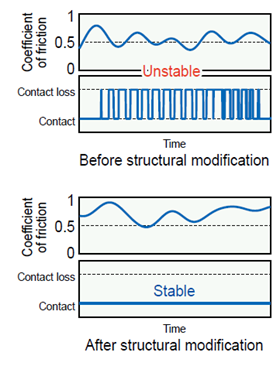30. Method for Reducing Unstable Vibrations of Pantographs Caused by Sliding Friction
When a train is running at low speed just after departure or just before stopping, a high coefficient of friction between the pantograph contact strip and the contact wire can cause significant unstable vibrations with continuous contact loss in the pantograph. This can lead to train operation becoming impossible or cause arcing that accelerates wear on the contact wire. However, until now, the mechanism causing these unstable vibrations had not been clarified, and no countermeasures based on the mechanism had been proposed.
Through analysis using a detailed pantograph model, we clarified that unstable vibrations occur when the vertical and longitudinal natural modes come close and amplify each other under a high coefficient of friction (Figure 1). Based on this mechanism, we proposed a flowchart for reducing unstable vibrations (Figure 2). In this flowchart, we evaluate whether significant unstable vibrations occur, either through FEM analysis using a detailed model or through low-speed sliding tests with an actual pantograph. Furthermore, by conducting experimental modal analysis and evaluating the proximity and amplification of modes, the natural modes requiring countermeasures are identified. Structural modifications, such as using softer plate spring, can then reduce unstable vibrations even under a high coefficient of friction (Figure 3).
This method allows for the design of pantograph structures and parameters that can maintain stable sliding even when the contact surfaces between the contact strip and the contact wire are rough and the coefficient of friction is high, enabling pantographs that contribute to more stable and reliable transportation.
Other Contents
- 27. Method for Estimating the Density of Newly Fallen Snow Using Dual-polarization Radar
- 28. Prediction Method for Long-term Deformation Behavior of Concrete Bridges Considering Water Content Conditions
- 29. Non-contact Disc Brake Enabling Power Regeneration in Trailers
- 30. Method for Reducing Unstable Vibrations of Pantographs Caused by Sliding Friction
- 27. Method for Estimating the Density of Newly Fallen Snow Using Dual-polarization Radar
- 28. Prediction Method for Long-term Deformation Behavior of Concrete Bridges Considering Water Content Conditions
- 29. Non-contact Disc Brake Enabling Power Regeneration in Trailers
- 30. Method for Reducing Unstable Vibrations of Pantographs Caused by Sliding Friction



